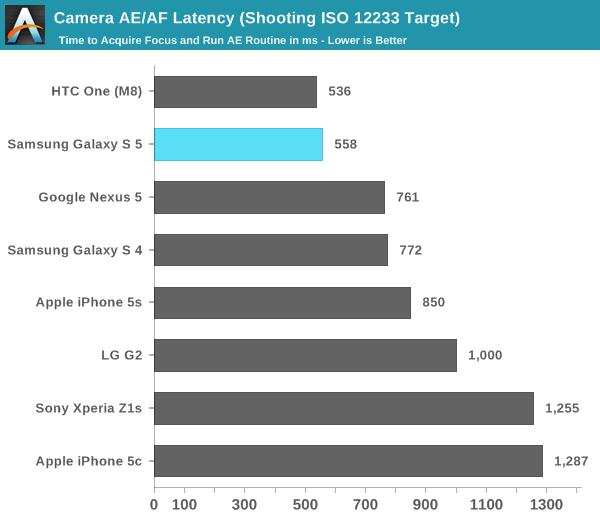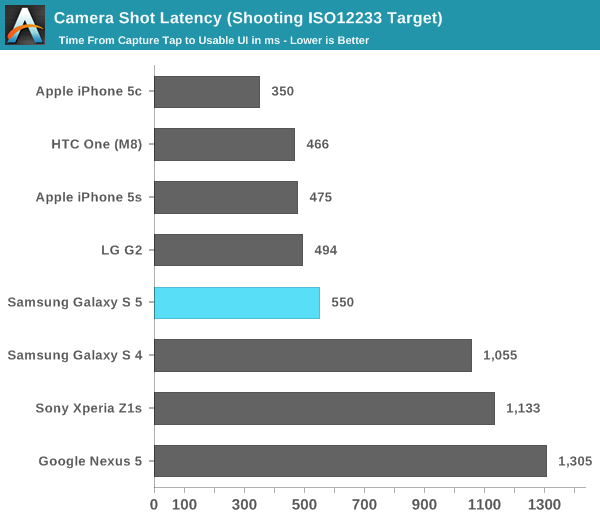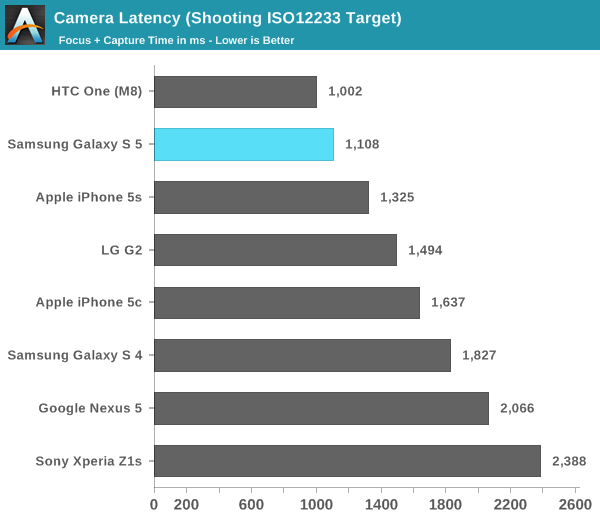Samsung Galaxy S 5 Review
by Anand Lal Shimpi & Joshua Ho on April 8, 2014 12:00 AM EST- Posted in
- Smartphones
- Samsung
- Mobile
- Galaxy S 5
Capture Latency
Along with its own rear facing camera sensor, the GS5 adapts a dual-mode autofocus system. Traditional AF designs in smartphones rely on testing contrast differences in order to determine when a point is in focus. With GS5, Samsung introduces a second mode: phase detection auto focus. Instead of relying (primarily) on contrast to determine focus, PDAF splits incoming light and compares intensity patterns to determine focus direction.
Low light scenes and scenes that can't generate appropriate phase info will default to contrast AF. PDAF appears to work across the camera's FOV although I did notice that the fastest AF times almost always happened in the center of the display.
Samsung claims a 300ms AF time thanks to its phase detection AF. In order to validate that claim I pointed a camera at a bunch of phones and measured AE/AF latency while preparing our ISO 12233 target shots from the previous page.
I measured from the moment I tapped the focus target to the time the image stopped moving (I didn't rely on the AF lock indicator as some devices report focus lock prematurely). There's a bit more variance than I'd normally like in these numbers due to the nature of the capture, although I'm working on getting a higher speed camera to smooth some of that out.

The GS5 definitely runs its AE/AF routine quickly, basically tying the M8 at the top of the charts here. The improvement over the GS4 is substantial, and there's even a big advantage over Apple's iPhone 5s. Note that if you move to lower light conditions you can see this number at least double, but that's something that impacts all of the devices here.
The Z1s is pretty frustrating because it has a great imaging system but an absolutely terrible camera UI. Focus speed is pretty bad compared to anything else here, basically on par with the iPhone 5/5c.
The shortest time to focus I was able to record on the GS5 was 450ms in a different test scene, compared to 516ms for the M8. The GS5 can definitely be a hair faster but I found the M8 to be comparable if not slightly quicker overall.
Focusing is just one piece of the puzzle, I also measured capture latency as well. Here I'm looking at the time between when I tapped the capture button on the screen and when the camera UI was ready to take another shot.

The GS5 remains solid, but here Apple actually pulls ahead. The 5c (and 5 by extension) are actually at the top of the charts here. Apple does some more work upon capture on the 5s, which is the only reason I can think of for the discrepancy here. Either that or the NAND on my 5s is in a dirtier state, impacting capture performance.
Either way there's a huge improvement in capture speed compared to the GS4. Capture latency is one area where the Nexus 5 is absolutely horrible in. The latest updates made AE/AF reasonably responsive, but the capture latency kills the experience on the N5.
This next chart combines the previous two values to give an overall picture of capture latency on these devices:

Samsung's PDAF and ISP companion seem to do their job well as the GS5 is substantially quicker than the GS4 at image capture. That being said, HTC's M8 is slightly faster by comparison.










296 Comments
View All Comments
doobydoo - Friday, April 11, 2014 - link
Hardly any phones offer different screen size options, including the Galaxy S4...OCedHrt - Tuesday, April 8, 2014 - link
What's with the constant 5s pitch. In the low light lab shot the z1s clearly has the better picture compared to 5s (less noise, similar brightness/tone) yet is not mentioned.rauelius - Tuesday, April 8, 2014 - link
No word in this review about the 16GB version only having 5GB of space for Apps? Come on, the press is the second to last bastion for consumer rights! Offering 16GB and advertising it as such when 70% of it is taken up by the OS, is as close to lying on the box as you can get. Also, SD cards are basically useless for apps at this point, so putting one on the phone, then having the press point it out is just a big middle finger in the face of the consumer.eastbei - Tuesday, April 8, 2014 - link
Well finally it is mentioned that amoled even with pentile is a better technology then IPS , LCD, etc. I personally hate pentiles but the true blacks that you get plus much better contrast, lower battery consumption and better colors make amoled the clear winner, now we just need someone else to start using them other then Samsung, I'd definintly get the g2 if it was amoled but I might be stuck with Samsung as I can't go back to an overbright backlit LCD phone.kmmatney - Tuesday, April 8, 2014 - link
One crappy thing about AMOLEDs is that they seem to get worse over time. On several older phones I have the screens are now discolored, and overall look crappy. I'll stick with IPS screens.Cyleo - Tuesday, April 8, 2014 - link
The device you refer to in your conclusion sounds a lot like the upcoming xperia Z2. I for one can't wait to see how it fares. Any plans on reviewing that device? I'm asking since I've noticed the Z1s pop up in this review. I know Sony's release schedule in the US can be a bit wonky.MrCrispy - Tuesday, April 8, 2014 - link
Why are things like removable battery, sd card, IR transmitter, HR monitor barely mentioned or completely ignored, while the fingerprint reader gets a detailed criticism? The fact is the S5 is a very well balanced phone.How exactly do the GS5 materials 'prevent it' from being a perfect device? This stupid myth about 'metal > plastic' needs to die, and its one this site likes to keep repeating. The GS5 is much more durable and waterproof compared to the 5S or M8, yet its seen as a tradeoff ?!! I don't want a metal body, plastic is shown to be better built and more durable.
kyuu - Tuesday, April 8, 2014 - link
There's plastic, and then there's plastic. Not all plastic is the same. The problem isn't that Samsung uses plastic; the problem is that they use cheap, crappy plastic.MrCrispy - Tuesday, April 8, 2014 - link
What makes the polycarbonate used by Samsung 'cheap' and 'crappy', besides subjective opinion?doobydoo - Friday, April 11, 2014 - link
The fact that it looks and feels cheap and crappy.